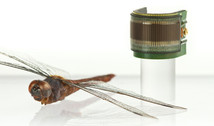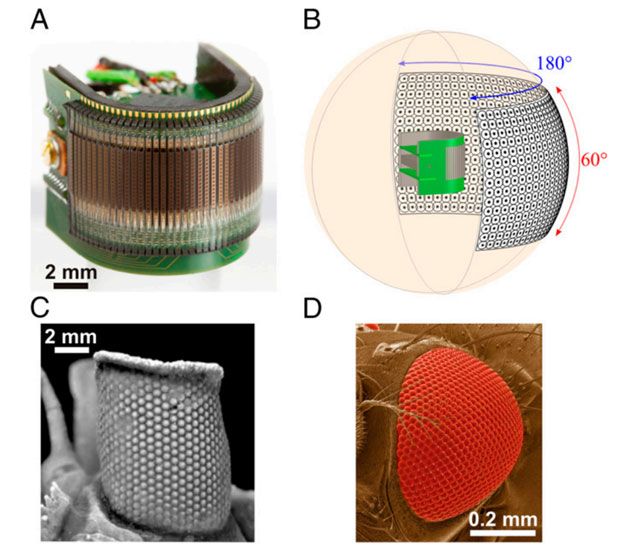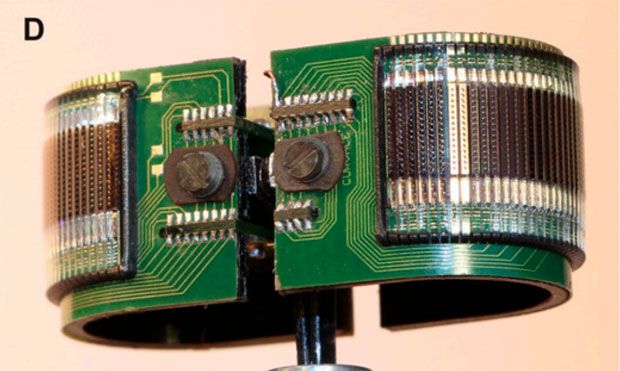/ News

Robotic Insect Eyes Destined for Next-Gen Micro Drones
Just a few weeks ago, IEEE Spectrum wrote about an artificial compound insect eye that was developed by a group of researchers based in the United States. Not to be outdone, a group from EPFL in Switzerland has announced their own artificial compound insect eye, and we got a hands-on a few weeks ago in Lausanne.
Generally, we like to make camera systems that work like our eyeballs do. And that's fine. But in a lot of ways, human eyeballs are terrible. The most successful class of animals ever, the arthropods, have gotten along just fine with compound eyes for a very long time, and the most sophisticated eyes of any animal are of the compound variety (belonging to our friend the mantis shrimp).
So obviously, compound eyes have something going for them, which is why researchers in general (and roboticists specifically) are so keen on developing their own versions. The eye to come out of EPFL this week is unique because it offers a huge insect-like field of view, very fast performance under all sorts of lighting conditions, and most notably, it's mechanically flexible: at just 1 mm thin, you can bend it into different shapes.
We got a look at this thing a couple weeks ago while we were visiting Dario Floreano's lab at EPFL, and it's totally cool:

It's amazing how the use of this flexible substrate enables sensors that are not just bio-inspired, but in fact end up nearly identical to the types of compound eyes that you find on everything from flies to trilobites. Here's a figure from the paper showing a comparison:

Image C shows the eye from an extinct species of trilobite, while Image D shows the eye from a fruit fly. Both the real and artificial eyes offer a horizontal field of view of 180 degrees, and they consist of a similar number of pixels. However, the artificial eye is significantly faster, operating at up to 300 hertz, while a fruit fly only updates at 100 hertz. Take that, nature!
It's important to note that these aren't the sort of cameras that you'd want to use to take pictures. What they're best at is sensing movement, or to be more specific, sensing changes in the intensity of light generated by motion. It doesn't sound like much (and it doesn't look like much, either), but it's how bugs navigate and avoid obstacles, and as anyone who's ever tried to swat a fly can attest to, it works rather well. It also works indoors, outdoors, in bright sun, and in shade (or even moonlight), and has no trouble adapting to abrupt transitions between any of these states, which is something that conventional cameras are lousy at.
Clearly, there are many advantages that these kinds of sensors can bring to robotics, especially in the context of lightweight aerial platforms. And there's no reason to stop at just one of 'em, either: put a couple CurvACE sensors together and all of a sudden you have a 360 degree panoramic sensor system the size of a couple of quarters:

Freaky. And awesome.
Going forward, we expect to see this tech integrated into robots, and there's also the potential for it to show up in lots of other applications. If it can be made inexpensively enough, we could end up with something like "imaging tape" that could be integrated into smart clothing, to provide a self-contained way of detecting distances to objects. Why? Because why not, that's why. But seriously, flexible sensors like these have the potential to enable all sorts of new applications that have been impossible until now, and we're excited to see what happens.
"Miniature Curved Artificial Compound Eyes," by Dario Floreano, Ramon Pericet-Camara, Stéphane Viollet, Franck Ruffier, Andreas Brückner, Robert Leitel, Wolfgang Buss, Mohsine Menouni, Fabien Expert, Raphaël Juston, Michal Karol Dobrzynski, Geraud L’Eplattenier, Fabian Recktenwald, Hanspeter A. Mallot, and Nicolas Franceschini, was published today inProceedings of National Academy of Sciences.
Special thanks to Dario Floreano and Ramon Pericet-Camara for showing us these eyes at EPFL.
[ CurvACE ]
Source: http://spectrum.ieee.org/automaton/robotics/robotics-hardware/epfl-curvace-artificial-compound-eyes-for-drones
/ About us
Founded by Russian entrepreneur Dmitry Itskov in February 2011 with the participation of leading Russian specialists in the field of neural interfaces, robotics, artificial organs and systems.
The main goals of the 2045 Initiative: the creation and realization of a new strategy for the development of humanity which meets global civilization challenges; the creation of optimale conditions promoting the spiritual enlightenment of humanity; and the realization of a new futuristic reality based on 5 principles: high spirituality, high culture, high ethics, high science and high technologies.
The main science mega-project of the 2045 Initiative aims to create technologies enabling the transfer of a individual’s personality to a more advanced non-biological carrier, and extending life, including to the point of immortality. We devote particular attention to enabling the fullest possible dialogue between the world’s major spiritual traditions, science and society.
A large-scale transformation of humanity, comparable to some of the major spiritual and sci-tech revolutions in history, will require a new strategy. We believe this to be necessary to overcome existing crises, which threaten our planetary habitat and the continued existence of humanity as a species. With the 2045 Initiative, we hope to realize a new strategy for humanity's development, and in so doing, create a more productive, fulfilling, and satisfying future.
The "2045" team is working towards creating an international research center where leading scientists will be engaged in research and development in the fields of anthropomorphic robotics, living systems modeling and brain and consciousness modeling with the goal of transferring one’s individual consciousness to an artificial carrier and achieving cybernetic immortality.
An annual congress "The Global Future 2045" is organized by the Initiative to give platform for discussing mankind's evolutionary strategy based on technologies of cybernetic immortality as well as the possible impact of such technologies on global society, politics and economies of the future.
Future prospects of "2045" Initiative for society
2015-2020
The emergence and widespread use of affordable android "avatars" controlled by a "brain-computer" interface. Coupled with related technologies “avatars’ will give people a number of new features: ability to work in dangerous environments, perform rescue operations, travel in extreme situations etc.
Avatar components will be used in medicine for the rehabilitation of fully or partially disabled patients giving them prosthetic limbs or recover lost senses.
2020-2025
Creation of an autonomous life-support system for the human brain linked to a robot, ‘avatar’, will save people whose body is completely worn out or irreversibly damaged. Any patient with an intact brain will be able to return to a fully functioning bodily life. Such technologies will greatly enlarge the possibility of hybrid bio-electronic devices, thus creating a new IT revolution and will make all kinds of superimpositions of electronic and biological systems possible.
2030-2035
Creation of a computer model of the brain and human consciousness with the subsequent development of means to transfer individual consciousness onto an artificial carrier. This development will profoundly change the world, it will not only give everyone the possibility of cybernetic immortality but will also create a friendly artificial intelligence, expand human capabilities and provide opportunities for ordinary people to restore or modify their own brain multiple times. The final result at this stage can be a real revolution in the understanding of human nature that will completely change the human and technical prospects for humanity.
2045
This is the time when substance-independent minds will receive new bodies with capacities far exceeding those of ordinary humans. A new era for humanity will arrive! Changes will occur in all spheres of human activity – energy generation, transportation, politics, medicine, psychology, sciences, and so on.
Today it is hard to imagine a future when bodies consisting of nanorobots will become affordable and capable of taking any form. It is also hard to imagine body holograms featuring controlled matter. One thing is clear however: humanity, for the first time in its history, will make a fully managed evolutionary transition and eventually become a new species. Moreover, prerequisites for a large-scale expansion into outer space will be created as well.
Key elements of the project in the future
• International social movement
• social network immortal.me
• charitable foundation "Global Future 2045" (Foundation 2045)
• scientific research centre "Immortality"
• business incubator
• University of "Immortality"
• annual award for contribution to the realization of the project of "Immortality”.



 LinkedIn
LinkedIn
 LiveJournal
LiveJournal
 Google
Google
 Twitter
Twitter
 Facebook
Facebook
 Я.ру
Я.ру
 ВКонтакте
ВКонтакте
 Mail.ru
Mail.ru